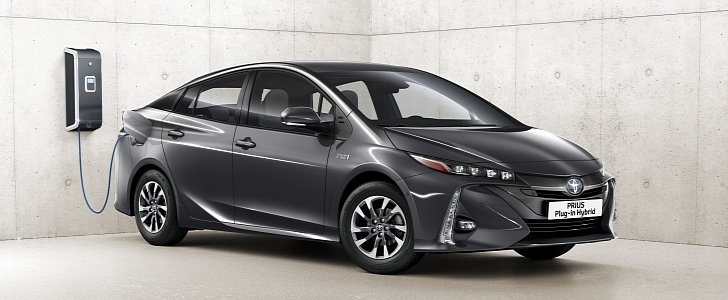For years, the Toyota Prius has been the symbol of anti-gas-guzzling - the green car of choice. In turn, that made it the preferred target for coal rollers as well as numerous jokes in TV shows or online memes, which eventually only helped build its reputation.
The Japanese hybrid's popularity grew steadily from its introduction in the US as a 2000 model year when Toyota only delivered 5,562 units. Thanks to more attractive design and improved hybrid powertrain - as well as the addition of several body types and the plug-in hybrid option - the Prius rose to 236,655 units overall in 2012.
For a hybrid, that was huge. Bear in mind the Nissan LEAF electric hatchback only sold about 350,000 units globally throughout its entire life, and it's still the world's best-selling battery-powered model - not for long, though, if Tesla's plans come to fruition.
Back to Toyota's hybrid, its market evolution since this 2012 peak has been a continuously negative trend, culminating with last year's sales of only 108,661 units. That's a loss of over 50 percent in just five years, and the worst part is it doesn't seem like there are any reasons to hope it'll get better.
So, what was it that lead to the Prius' downfall? Well, it's actually a multitude of causes that all got together and plotted against the Japanese model. For one thing, it wasn't the only hybrid on the market anymore, with lots of other manufacturers offering tempting alternatives, something the first models didn't have to deal with.
Then there's the fact the electric vehicles have slowly but surely been taking over the eco-warrior role, leaving the Prius to look a bit silly, like a car that couldn't make up its mind. It was considerably cheaper than an EV, but more expensive than a regular gas-powered car, and with the price of fuel going down, its efficiency stopped being that relevant.
One other aspect that shouldn't be overlooked (not that you could easily do it) is the exterior design of this latest generation. The new Prius was greeted by raised eyebrows ever since its launch, and we doubt the Japanese carmaker didn't get the same reaction from the study groups it must have run before its launch so the decision to go on with this polarizing look is baffling.
In the end, you could summarize by saying it was all down to Toyota's inability to react to a changing global market and relying too much on its domestic one. The company is showing signs of switching over to the all-electric propulsion systems, but it'll be playing catch-up. As for the Prius, it'll be interesting to see if there's going to be a new generation at all, and if so, where will Toyota decide to take this nameplate.
For a hybrid, that was huge. Bear in mind the Nissan LEAF electric hatchback only sold about 350,000 units globally throughout its entire life, and it's still the world's best-selling battery-powered model - not for long, though, if Tesla's plans come to fruition.
Back to Toyota's hybrid, its market evolution since this 2012 peak has been a continuously negative trend, culminating with last year's sales of only 108,661 units. That's a loss of over 50 percent in just five years, and the worst part is it doesn't seem like there are any reasons to hope it'll get better.
So, what was it that lead to the Prius' downfall? Well, it's actually a multitude of causes that all got together and plotted against the Japanese model. For one thing, it wasn't the only hybrid on the market anymore, with lots of other manufacturers offering tempting alternatives, something the first models didn't have to deal with.
Then there's the fact the electric vehicles have slowly but surely been taking over the eco-warrior role, leaving the Prius to look a bit silly, like a car that couldn't make up its mind. It was considerably cheaper than an EV, but more expensive than a regular gas-powered car, and with the price of fuel going down, its efficiency stopped being that relevant.
One other aspect that shouldn't be overlooked (not that you could easily do it) is the exterior design of this latest generation. The new Prius was greeted by raised eyebrows ever since its launch, and we doubt the Japanese carmaker didn't get the same reaction from the study groups it must have run before its launch so the decision to go on with this polarizing look is baffling.
In the end, you could summarize by saying it was all down to Toyota's inability to react to a changing global market and relying too much on its domestic one. The company is showing signs of switching over to the all-electric propulsion systems, but it'll be playing catch-up. As for the Prius, it'll be interesting to see if there's going to be a new generation at all, and if so, where will Toyota decide to take this nameplate.











